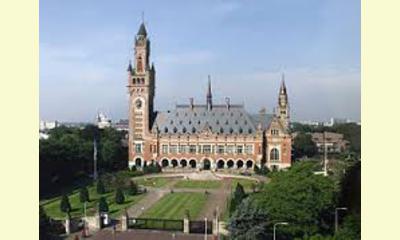|
|
100th Anniversary of the Peace Palace in The Hague
un articulo por Dr. Peter van den Dungen, Peace Studies, University of Bradford
This year (2013) we are celebrating the 100th
anniversary of the opening of the very first
building in the world dedicated to the pursuit of
a culture of peace: the Peace Palace in The Hague,
The Netherlands.

The Peace Palace
click on photo to enlarge
Among the institutions it houses today is the
International Court of Justice of the UN. The
Palace was constructed to provide a worthy home
for the Permanent Court of Arbitration, the main
result of the first Hague Peace Conference (1899).
The Scottish-American steel tycoon, Andrew
Carnegie, paid for the building, and was present
at the opening in August 1913. He was a great
opponent of war, who believed that peaceful
resolution of conflict between states, such as by
arbitration, was about to put an end to organised
mass murder.
Carnegie was the richest man in the world, and was
famous for saying, ‘The man who dies rich, dies
disgraced’. He gave away most of his fortune, much
of it to promote world peace. Today, there are
many philanthropists, some of whom have followed
in his footsteps. But more are needed.
On 2 & 3 September 2013, an international
conference entitled ‘Celebrating Peace
Philanthropy and Furthering Peace Education – In
the Footsteps of Andrew Carnegie’ will be held in
the Peace Palace. The conference will highlight
major instances of peace philanthropy today – such
as the gift to the UN of $ 1 billion by CNN
founder Ted Turner, and the World Peace Fellowship
Programme established by Rotary International.
The conference will also address the need for
global peace education programmes in order to
strengthen the foundations for a culture of peace
and nonviolence. Several large-scale peace
education projects will be presented. For
instance, the creation of Hiroshima-type peace
museums in the capital cities of the nuclear
weapons states. This would have a major impact on
popular opinion, and greatly advance the cause of
nuclear disarmament.
Likewise, the establishment of Martin Luther King’s
centres (like the one in Atlanta, Georgia, USA)
around the world to promote nonviolent social change
would be highly beneficial to reduce violent
conflict, both domestically and internationally.
These and many other imaginative peace education
projects require financing – and thus
philanthropists who continue Andrew Carnegie’s
example. In the words of UN Secretary-General Ban
Ki-moon: ‘The world is over-armed and peace is
underfunded’. Today’s millionaires and
billionaires can do something about this. The
conference is being organised by the International
Network of Museums for Peace (INMP), with
secretariat in The Hague, in cooperation with the
Peace Palace. For the full programme and
registration details, please see www.inmp.net
|








|
DISCUSSION
Pregunta(s) relacionada(s) al artículo :
How can we develop the institutional framework for a culture of peace?,
* * * * *
Comentario más reciente:
:
This discussion question applies to the following articles:
100th Anniversary of the Peace Palace in The Hague
Parliaments Preparing for International Day of Democracy
Sixth Summit of Global Alliance for Ministries and Infrastructures of Peace
Global Alliance for Ministries and Infrastructures for Peace (GAMIP) 2013 Switzerland Summit
Ghana: Most Rev. Prof Asante: I have a dream for peace
Rwanda: 3rd African Alliance for Peace Summit
Union Interparlementaire célèbre 125 années d’action parlementaire internationale au service de la paix et de la démocratie
Inter-Parliamentary Union to mark 125 years of global parliamentary action on peace and democracy
One billion signatures for peace
Civil society has a critical role to play in ensuring lasting peace in Latin America: Tunisian Nobel Peace prize winner Ali Zeddini, speaking in Colombia
Let’s mark Canada’s 150th birthday by establishing a Department of Peace
For articles since 2016, click here .

|
|









